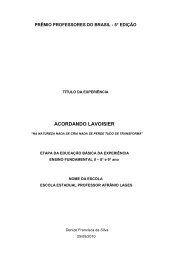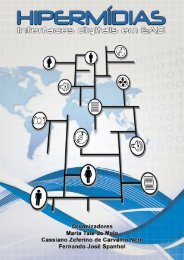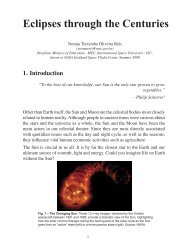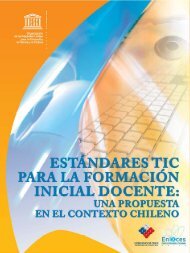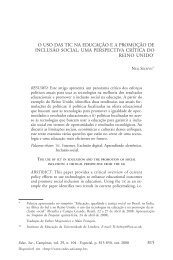BIO-CULTURAL COMMUNITY PROTOCOLS - Portal do Professor
BIO-CULTURAL COMMUNITY PROTOCOLS - Portal do Professor
BIO-CULTURAL COMMUNITY PROTOCOLS - Portal do Professor
You also want an ePaper? Increase the reach of your titles
YUMPU automatically turns print PDFs into web optimized ePapers that Google loves.
PART II / CHAPTER 6<br />
flood and air control), cultural services (such as aesthetics,<br />
recreation and spirituality), and supporting services<br />
(such as the cycling of nutrients or other mechanisms that<br />
maintain the conditions for life on earth). 4<br />
The Assessment<br />
exercise, which included more than 1,300 scientists from<br />
more than 95 countries, found that 60% of the resources<br />
examined were being degraded faster than they<br />
can recover. 5<br />
In the context of PES schemes, ESS are usually divided into<br />
the following related categories based on the type of service<br />
they are providing: carbon sequestration, biodiversity<br />
protection, watershed protection, and landscape beauty.<br />
The management or protection of one ecosystem often<br />
generates more than one type of service, which is referred to<br />
as the bundling of services. ESS can also be divided based on<br />
whether the spatial boundaries of the services are provided<br />
locally, regionally or globally. 6<br />
A landmark study by Robert Constanza et al. in 1998, which<br />
became the basis of a significant amount of thinking on<br />
ESS valuation, estimated the global value of ESS to over $33<br />
trillion per year, the vast majority of which remains outside<br />
the market. 7<br />
Although the quantitative valuation of ESS<br />
is complex and susceptible to subjectivity 8<br />
the economic<br />
value of ESS remains undisputed, with an increasing<br />
acknowledgement that such costs need to be integrated<br />
into the market in order to increase the protection of<br />
ecosystems generating ESS in the first place.<br />
2.2 Payment for Ecosystem Services<br />
The PES framework promotes the conservation of natural<br />
resources in the marketplace by providing incentives to<br />
incorporate sustainable practices into production and<br />
resource management. PES hinges on the principle that<br />
<strong>BIO</strong>-<strong>CULTURAL</strong> <strong>COMMUNITY</strong> <strong>PROTOCOLS</strong> IN THE<br />
CONTEXT OF PAYMENT FOR ECOSYSTEM SERVICES<br />
“resources users and communities that are in a position to<br />
provide ESS should be compensated for the cost of their<br />
provision and those who benefit from these services should<br />
pay for them, thereby internalizing these benefits.” 9<br />
PES agreements are mutually beneficial contracts between<br />
consumers of ESS and the suppliers of these services.<br />
A widely accepted definition of PES by Sven Wunder<br />
describes them as …a voluntary transaction in which a welldefined<br />
environmental service (ES), or a form of land use<br />
likely to secure that service is bought by at least one ES buyer<br />
from a minimum of one ES provider if and only if the<br />
provider continues to supply that service (conditionality). 10<br />
PES seeks to reward individuals who conserve their<br />
environment by offering them financial or other incentives<br />
in an effort to positively reinforce and improve<br />
their behavior. 11<br />
The party supplying the environmental<br />
services, known as the provider, holds the property or related<br />
rights over an environmental good that provides a flow of<br />
benefits in terms of a certain ESS to the demanding party<br />
(user) in return for compensation. Interestingly, users of ESS<br />
are willing to pay a price lower than their welfare gain due to<br />
the services acquired, while providers are willing to accept a<br />
payment that is greater than the cost of providing the services. 12<br />
There is currently no commonly agreed-on definition of<br />
PES schemes, but there is a series of classifications under<br />
which PES schemes fall, based on the nature of the ESS<br />
provided, its geographical scope, the structure of the market,<br />
and the type of payment involved. There is a great diversity<br />
of existing models of PES schemes usually adapted to very<br />
specific conditions of each scheme and location. 13<br />
The most common forms of PES are carbon storage and<br />
sequestration, wetlands conservation, watershed protection<br />
(including soil protection), and species, habitat and<br />
biodiversity conservation. 14<br />
4. Millennium Ecosystem Assessment. 2005. Ecosystems and Human Well-Being. Synthesis Report. http://www.millenniumassessment.org/en/index.aspx<br />
5. UNEP, 2008, PES – A Primer. http://www.unep.org/pdf/PaymentsForEcosystemServices_en.pdf<br />
6. “Payments for ecosystem services – issues and pro poor opportunities for development assistance” by Helle Munk Ravnborg, Mette Gervin Damsgaard and<br />
Kim Raben, DIIS Report, 2007:6.<br />
7. “The value of the world’s ecosystem services and natural capital” Robert Constanza et al. Ecological Economics 25 (1998) 3–15.<br />
8. See for example: Pagiola, S., von Ritter, K., and Bishop, J. 2004. How Much is an Ecosystem Worth? Assessing the Economic Value of Conservation. IUCN, TNC, The World Bank.<br />
9. Mayrand, Karel, and Marc Paquin, 2004, Payments for Environmental Services: A Survey and Assessment of Current Schemes, Unisféra International Centre, from<br />
10. Supra note 6.<br />
11. Oliver, J., Emerton, L., Smith, M., 2008, Design Payments for Ecosystem Services: Report from the East Asian Regional Workshop (Hanoi, April 2008),<br />
IUCN, last visited 5 June 2009.<br />
12. Bulte, E., Lipper, L., Stringer, R., Zilberman, D., 2008, “Payments for ecosystem services and poverty reduction: concepts, issues, and empirical perspectives,”<br />
Environment and Development Economics, 13 , pp 245-254.<br />
13. Supra note 10.<br />
14. Ferraro, Paul, 2007, Regional Review of Payments for Watershed Services: Sub-Saharan Africa, Andrew Young School of Policy Studies Department of Economics at<br />
Georgia State University, from last visited 9 June 2009.<br />
59





